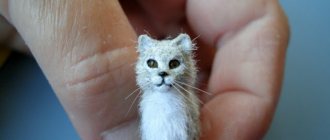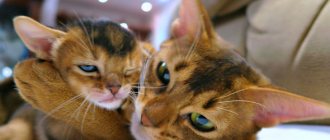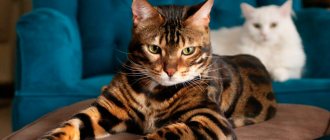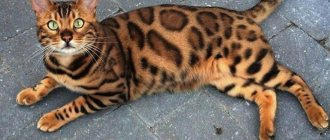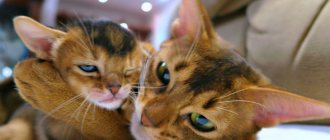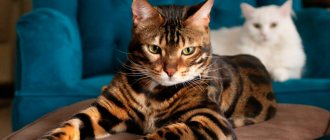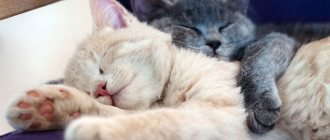Cats are the most popular pets. Therefore, breeders have worked hard and brought out many different breeds. Among them there are both giant animals and the most miniature ones, more like kittens. They are in demand among breeders all over the world.
Cats have long been no longer considered as a tool in the fight against rodents. In recent decades, the activities of breeders have been aimed at breeding ornamental breeds with an unusual appearance. Due to the fact that people have become fashionable for miniature pets, many dwarf cat breeds have been bred.
The vast majority of small cats were created through gene mutation and hybridization. Therefore, these breeds have certain disadvantages. The main ones:
- Limited gene pool.
- Little knowledge of hereditary pathologies.
- Instability of the species.
Despite this, representatives of dwarf cat breeds have a number of advantages:
- Unusual appearance.
- Such animals are distinguished by a calm disposition, kindness, and easy character. They very rarely show aggression or hostility.
- As a result of numerous studies, it has been proven that miniature cats help their owners cope with mental problems.
We present a rating of the 10 smallest cat breeds, whose weight does not exceed 4 kg.
Rating:
- Skif-tay-don
- Skookum
- Munchkin
- Singaporean
- Dwelf
- Minskin
- Kinkaloe
- Bambino
- Napoleon
- Lemkin
Crumbs from the Guinness Book of Records
The record holder among miniature animals is a tabby cat named Mr. Pibbles. He lives in one of the veterinary clinics and has no owners. At 2 years old, the pocket cat weighed only 1.3 kg and its body length was 15 cm.
Experts suggest that he stopped growing due to an irreversible genetic failure that occurred in infancy.
Another baby from the pages of the Guinness Book of Records - Tinker Toy. The little native of the American state of Illinois weighed only 700 g with a height of 7 cm and a body length of 19 cm.
We are taking care of a small kitten. Hygiene
The next thing you definitely need to purchase is a nail clipper. And it is also advisable to use it when the kitten is still small, so that he gradually gets used to the fact that once every few months the very tips of his claws will be cut off.
For those who are afraid to trim a kitten’s claws themselves for the first time, you can contact a veterinarian who will show you how to do it correctly.
How to raise a kitten
In raising a kitten, the character it already has from birth plays a big role.
- The main thing in how to care for a British kitten is a strict, clear system in the sense that if you need to prohibit a kitten from lying in one place or another, then you need to go to the end.
- You should never lay your hand on your pet. Even if the kitten made a puddle or tore something off, this is not his problem, but the problem of the owner who created the wrong conditions for his living. The main thing in education is endurance, patience and the ability to insist on one’s own.
TOP 10 most miniature species of wild cats
The rating is compiled “as it is” (it cannot be said that a person knows all the breeds of wild cats existing in nature).
• 10 • pampas cat
Found in South America, it has a dense build and is similar in color to a leopard. The weight of an adult is up to 8/11 kg (feline/cat), body length is up to 75 cm.
• 9 • jaguarundi
A miniature copy of a jaguar - as the name suggests. They have a flexible body and strong but short legs. Height at withers - up to 35/30 cm (males/females). Weight - up to 9 kg. They are found in a variety of places - savannas, forests, tropics. Secretive animals, but lead a diurnal lifestyle. They feed on small mammals, amphibians, birds, and fish.
• 8 • margay
The “long-tailed cat” (as it is called in its homeland) lives in South and Central America. The body length of this cat is 60~80 cm + 10 tail, and the weight of males reaches 8 kg. Leopardus wiedii leads a solitary nocturnal lifestyle, climbs trees well (and spends most of its life there). In America, hunting cats of the Margay breed is strictly prohibited.
• 7 • forest cat
Felis Silvestris is brown with black stripes. The body is up to 80 cm long (the tail is almost 35 cm), the weight of the cat is up to 6/8 kg, the height at the withers is about 35 cm. They are found mainly in Europe, northern Asia and Africa (African subspecies are the smallest in size).
• 6 • marble cat
Pardofelis marmorata inhabit Southeast Asia. Their body length is less than 55 cm + 50 cm counterweight tail, height is 45~62 cm, and weight is 2~5 kg.
• 5 • Kalimantan cat
Lives near Indonesia and Malaysia. Weight - from 2.3 to 4.5 kg, height less than 40 cm, body length - almost 60 cm. Almost elusive - the cat cannot be photographed in the wild.
• 4 • sand cat
The body length of these cats is from 65 to 90 cm (and almost half of this value is in the tail). The weight of males reaches 3.5 kg, and females - 3 kg. Dune cats live in deserts and rocky valleys and are nocturnal. They seem very cute, even though they are carnivores - they hunt jerboas, spiders, lizards, and insects.
• 3 • “rusty” cat
“Rusty” is its slang name (in Latin the breed sounds like Prionailurus rubiginosus). It became “rusty” because of its characteristic color - a mixture of gray, red, brown colors with an abundance of red spots on the body. It lives in Sri Lanka and southeast India. The height of a “rusty” cat does not exceed 30 cm, length (including tail) - up to 80 cm, weight - from 1.5 to 2 kg. Endangered species (the population is extremely small).
• 2 • Chilean cat
Kodkod (another name for Chilean cats) is an inhabitant of Chile and Argentina. The height at the withers does not exceed 22 cm, weight - from 1.5 to 3 kg, body length - up to 70 cm.
• 1 • black-footed cat
Black-footed cats (Felis Nigripes) have a body length of half a meter, a height of up to 20 cm, and the average weight of an adult is 1.8 kg. But don’t be fooled by the cute eyes and size of this baby - she skillfully hunts birds and rodents, and in captivity becomes very aggressive.
But there are representatives of the cat family so small that they can even be confused with rodents.
Buying a dwarf kitten
It’s hard to remain indifferent at the first glance at a touching little cat—a completely natural thought immediately arises: “And I want one like that...”.
It's impossible to remain indifferent to these little cuties.
How to decide on the breed
If you have seriously decided to engage in exhibition and breeding activities with cat minis, then such a desire is unlikely to have arisen spontaneously: you have probably already thoroughly prepared both theoretically and practically, and you do not face the difficult problem of choice - you have definitely decided on your breed. But if you just really want a small living charm to appear in your house, which will forever preserve the size and sweet disposition of the kitten, this is more complicated, and you need to weigh the pros and cons.
- Decide on your preferences - do you want a fluffy, short-haired or completely “bald” cat?
- Study the equipment - carefully read articles about the breeds you like, watch videos and photographs.
- Decide what level of animal you want to purchase: show, breed or pet class.
- Soberly weigh your financial capabilities - minis are not cheap, will you later regret the impulsive purchase?
- Discuss the purchase with family members - a pet should be a desirable acquisition for everyone, and not just for you personally.
- Find out where there are breed nurseries, find reviews about their work and pets.
- First, find specialists and consult with them - it is better to have a knowledgeable person help you in your choice.
How to choose a kitten
Nowadays it is not a problem to get the kitten you like literally from anywhere in the world - breeders and carriers will ensure delivery of the baby from home to home. But if there is such an opportunity, come for your little one yourself - you are purchasing not just a living toy, but a new family member, and personal contact in this case is very important. At the same time, get to know the breeder better, look at the kitten’s parents and the conditions in which they are kept.
When choosing a kitten, meet its mother
Do not hesitate to ask questions to the breeder - it is better to prepare a list of them in advance. Ask, among other things, about the health of your baby's parents, as well as kittens from previous litters, and whether they have had genetic tests. Draw up a contract for the purchase of a kitten - a responsible breeder will never refuse such a step.
Of course, neither all these measures nor a thorough examination of the baby guarantees that you are purchasing a healthy animal that fully meets the requirements of the breed standard. But you will know that you did everything you could for this - and may luck be with you and with the little tailed miracle that will enter your home!
Maybe this baby is waiting for you?
